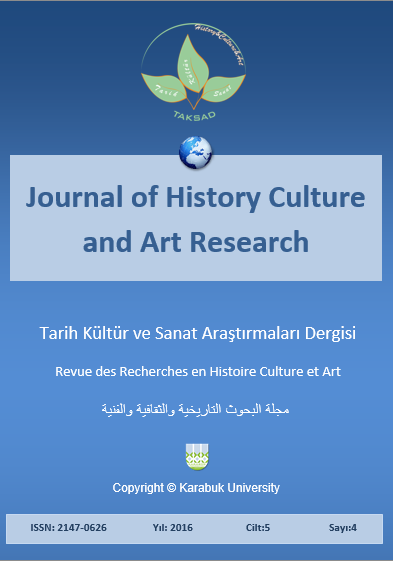Investigating the Effect of Pedestrian-Oriented Spaces on the Culture and Identity of Urban Spaces
DOI:
https://doi.org/10.7596/taksad.v5i4.576Keywords:
Sidewalk, Pedestrian-Oriented, Culture, Identity, Urban Space.Abstract
Abstract
The presence of people in the city follows many cultural and social effects. The pedestrian-oriented spaces result in the presence of more pedestrians and hence increase cultural and social values; however, today with increasing cars, pedestrians are not considered more which significantly reduces the number of pedestrians walking in urban areas as well as cultural and social values. Pedestrians can also affect the urban identity. In this paper, the effect of pedestrians on the culture and identity of the city had been discussed. By investigating the current academic literature, studies concerning the pedestrians, urban space, culture and urban culture, identity and urban identity have been collected and finally, the effect of pedestrian-oriented spaces on the culture and urban identity have been discussed. Since, the historic fabric of the city is the symbol of identity, part of this study discussing successful pedestrians that had been made in historical context.
References
Naghizadeh, Mohammad. (1999). Identity manifestation of culture in environment, Journal of Abadi, No. 34 and 35, Tehran.
Goudarzi Soroush, Mohammad Mehdi. Goudarzi Soroush, Khalil (2013). Recognition of the concept of identity in the urban environment (case study: Bu-Ali Hamadan street). Studies Quarterly in Islamic Iran. Third year. No 11. Page 101 107.
Code of Designing of Urban routes (1996). walking paths, Department of Housing and Urban Development, section 10.
Abbaszadeh, Shahab. Tamri, Sooda (2012). Analysis of factors affecting the spatial quality improvements of sidewalks to enhance the level of social interactions Case Study: Tarbiat and Valiasr axes of Tabriz. Scientific and research Journal of Urban Studies. Fourth number. Page 96.
Madanipour, Ali (2000), urban space design, translation of Farhad Mortazaei, Tehran, processing companies and urban planning publications.
Bahreini, Hossein (1998). The process of urban design, Tehran University Press.
Smith, Philip (2001). Cultural theory: An introduction. First edition. Blackwell Publishıng.
Kroeber, Alfred L. Kluckhohn, Clyde (1952). Culture: a critical review of concepts and definitions.
Piran, Parviz (2001). Urban culture. Journal of urban management. No. 8, pp. 6-17.
Mumford, Lewis (1937). What is a City? P. 91.
Nazari, Ali Ashraf (2007). National identity and Collective unity (Reflection on individual and collective aspects of identity). Specialized Journal of Tarikh pazhohan. No. 12. pp. 122-150.
Al-Taie, Quli (2003). Separation of ethnic identity in Iran. Shadegan publication. P. 34.
Naghizadeh, Mohammad (2006). Reflection on the trend of square transformation in Iranian cities. Fine Arts. No. 25, pp. 15-24.
Nofel, Alireza. Kolbady, Parin. Pourjafar, Mohammad Reza (2009). "Investigation and evaluation of effective indicators in urban identity (the case of Jolfa district of Isfahan)." Journal of architecture and utopia urbanism. Volume 2. No. 3. pp. 57-69.
Hatefi Farajian, Fereshteh. Ali Abadi, Tayebeh. (2014). The Role of walk axes in giving identity to the texture and physical structure of the city (Case Study: Street koohsangi in Mashhad). The Sixth National Conference of planning and urban management, with an emphasis on the components of Islamic city. Mashhad, Iran. 12 and 13 November.
Mahdavinejad, Mohammad Javad. Bemanian, Mohammad Reza. Khaksar, Neda. (2010). "Architectural identity, explaining the meaning of identity in terms of pre-modern, modern and post-modern."Journal of city identity. Volume 4. No. 7. pp. 113-122.
Nasr, Tahereh. (2014). Analysis of the meaning of "identity" in measuring paradigm "analysis vivification in the urban fabric." Volume 8, Issue 18, pp. 13-26.
Nasr, Tahereh. Majedi, Hamid. (2013). Take the issue of identity in urbanization. Journal of architecture and utopia urbanization. Volume 5. No. 11. pp. 269- 277.
Hosseinpour, Ali. Gharib, Omid (2012). Pedestrian-oriented spaces and strategies for reducing urban pollutants, Transport and Traffic Engineering Twelfth Conference of Iran, Tehran-Iran. 19 to 20 February.
Farrokhi, Maryam (2010). The role of walk axes in urban sustainability, case study: Tarbiat pedestrian in Tabriz. The first conference on sustainable urban development. Tehran Iran. 23 to 24 November.
Pakzad, Jahanshah (2012). Directory of designing urban spaces in Iran. Tehran: Shahidi publication.
Asadollahi, Shiva (2004). Attention to pedestrian movement in urban centers. Municipality's Monthly. Sixth year. No. 66. pp. 68-71.
Lashkari, Elham. Khalaj, Mehrshad (2011). "The arena sidewalks to create vitality, identity and collective memory-Case study: Marvi alley-Tehran, focus of the article: pesesterian life and social life of the city". International Conference on pedestrian life in the city. Tehran Iran. 4 to 6 March.
Saadati, Ali Mohammad (2015). Role of sidewalks in the revitalization and regeneration of historic contexts. Scientific- education Journal of Shahrnegar. Fifteenth year. No. 73-74. pp 20-30.
Nagsh-e- Jahan Pars, Engineering Consulting (2005). Detailed Plan of Tabriz Historical-Cultural Sector, Municipality of Tabriz Press.
Downloads
Published
How to Cite
Issue
Section
License
All papers licensed under Creative Commons 4.0 CC-BY.- Share — copy and redistribute the material in any medium or format
- Adapt — remix, transform, and build upon the material for any purpose, even commercially.
Under the following terms:
Attribution — You must give appropriate credit, provide a link to the license, and indicate if changes were made. You may do so in any reasonable manner, but not in any way that suggests the licensor endorses you or your use.
- No additional restrictions — You may not apply legal terms or technological measures that legally restrict others from doing anything the license permits.







